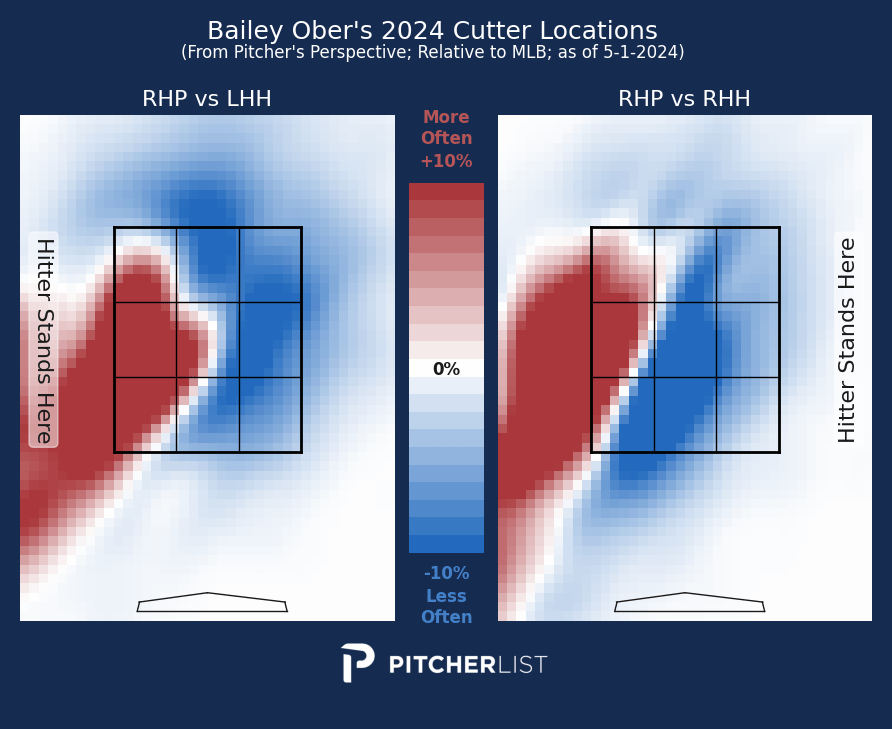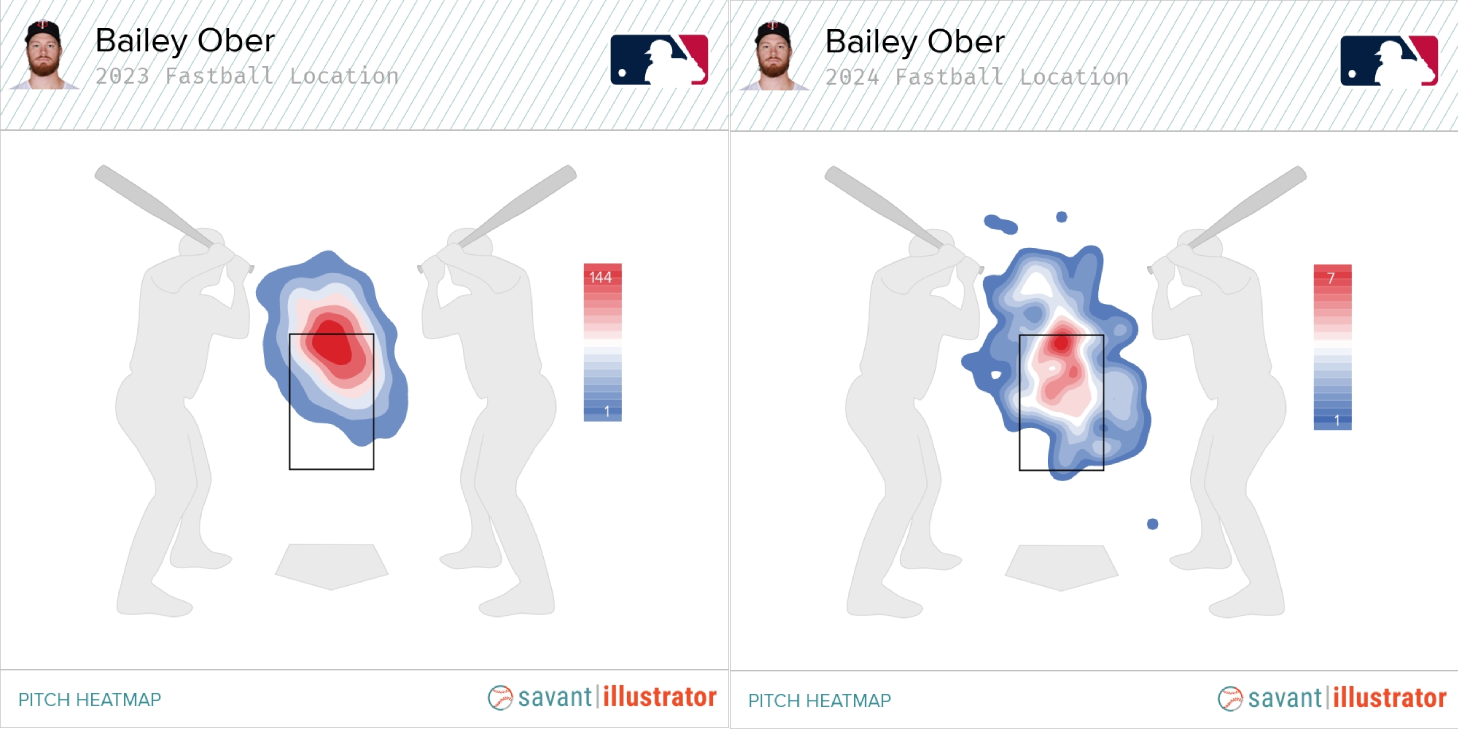Bailey Ober was a fun breakout pick heading into this season. After some usage changes led to a dominant stretch at the end of 2023, it logically made sense to see that continuing this year.
In Bailey Ober’s last five starts of the season, he started to lean more heavily on his changeup.
The result:
30.6 K%
0.82 WHIP
26.5 K-BB%
3.12 SIERA
3.43 xFIP
15.1 SwStr% pic.twitter.com/1nXAgdhyOP— Michael Simione (@SPStreamer) January 15, 2024
Then, he shows up at Spring Training with more tools than before. The breakout is imminent, right? He’s up a tick in velocity and added a cutter; it seemed too good to be true!
Six starts into the season, and it’s been a mixed bag of results. Granted, the ERA is inflated from his first start of the year (1.1 innings, 8 ER), but the peripherals don’t imply that something has changed ability-wise.
The most surprising change is a 2% decrease in strikeout rate, but the 4.55 ERA/3.67 FIP suggests he’s been slightly unlucky. Overall, things look to be the same in Oberworld, which is considerably underwhelming given the changes he made coming into his fourth MLB season.
Ober’s new cutter has been successful, but at a significant cost. His bread-and-butter approach of high fastballs has suffered, limiting the 2024 breakout.
A Cutter That Achieves Its Goal
Cutters have become one of the most effective new pitches a pitcher can add. They’re a platoon-neutral pitch that suppresses contact and can prevent home runs. From a movement perspective, they can “bridge” the fastball to the slider. Most players who add a cutter already have a fastball and slider but need something to approach opposite-handed hitters or limit a contact problem. Especially at lower velocities, cutters are not used for whiffs.
Ober previously had a home run problem (career 1.39 HR/9) and could use another pitch against lefties, making him a perfect candidate for a cutter. He throws his new cutter 26% of the time, only behind his fastball, and it’s used to attack all hitters: the cutter has 28% usage vs. RHB and 24% usage vs. LHB.
Introducing a cutter to Ober’s arsenal allows him to have a pitch for almost all velocity bands, a useful asset for attacking hitters multiple times through the order.
Adding the cutter balances out his approach by velocity, putting hitters even more off-balance by having to worry about a harder version of the slider. It’s a slow cutter at 86.4 mph, but he gets 3.8 inches of horizontal break (68th percentile) and only 5.7 inches of iVB (18th percentile), meaning it’s cutting and dropping more due to its lower velocity. Compared to his 80 mph slider, which gets 12.0 inches of horizontal break (92nd percentile) and 1.1 inches of drop (14th percentile; most sliders have some rise), it tunnels very effectively.
It also tunnels with the changeup since they’re in a similar velocity band.
The cutter effectively plays off of both secondaries, mimicking the slider’s movement and the changeup’s velocity.
With that, the emphasis early on Ober’s cutter has been its pristine location. It has a 113 in PLV’s Location+ and a 107 in Fangraph’s Location+, ranking 10th among starting pitchers’ cutters (min. 30 IP). The strike zone plot makes it easy to see why:

He consistently gets the pitch on the inner half of the plate to both RHB and LHB. His 88% gLoc% (glove side location) ranks in the 98th percentile for cutters.
While Ober’s cutter does bridge the fastball to the slider, he isn’t using the pitch as a means to get to the slider. Against RHB, Ober is throwing the cutter 29% of the time in two-strike counts, second-most of his arsenal, only behind the fastball (32%). Against LHB, he’s throwing it 18% of the time in two-strike counts, behind the fastball (30%) and changeup (38%). His cutter, at 86 mph, isn’t this filthy pitch that’s going to make hitters look silly at the plate. Instead, it will get weak contact and called strikes, and Ober’s two-strike cutter usage suggests he isn’t hunting for strikeouts.
The cutter’s Str-ICR% is 57%, which is in the 78th percentile for cutters. Str-ICR%, or strikes minus ideal contact rate, is a stat designed towards WHIP. Ober has always succeeded in limiting walks and hits, and this pitch emphasizes that skill. Since 2022, Ober’s 1.06 WHIP ranks 17th in baseball (min. 200 IP), behind Freddy Peralta and ahead of Aaron Nola. In terms of other results, it has a .259 AVG against and a .354 xSLG, indicating that hitters are struggling against the pitch.
The cutter has an outrageous 98% zone-contact rate against it, essentially saying that hitters don’t miss on swings in the zone at all. It also generates more foul balls than most other cutters, which means that Ober is throwing more pitches in an at-bat anyway, regardless of whether he is trying to punch a batter out or not. It does get a good amount of chases (41% chase rate), but it stands no chance in the zone.
The cutter has suppressed contact and been an effective new offering for Ober, but its location has harmed the four-seam fastball. While it could be from a cue for Ober when he throws the cutter (he called it “something that’s hard and goes left“) or crossover with grips (Gerrit Cole had mentioned unforeseen overlap when he added a cutter), there seems to be a side effect from the new cutter. The cutter’s lower target has brought the fastball’s location down with it.
A Fastball That Now Struggles
Bailey Ober’s original bread-and-butter was a fastball above the zone and a changeup that fell right into it. With 7.3 ft. of extension (95th percentile), he could effortlessly dot the top of the zone and go above for whiffs. This year, we’ve seen different results from the fastball.
The fastball is getting fewer chases and fewer whiffs overall because it is no longer being thrown up and above the zone. In 2023, the pitch had a 79% hiLoc% (high location), and in 2024, it currently has a 62% hiLoc%. While that’s still in the 82nd percentile, Ober is no longer an outlier when it comes to the frequency of high fastballs. He’s locating it just slightly lower than in previous years, but going slightly lower than above the middle of the zone is… right in the heart of the plate.

So now, when Ober misses his spot, it’s middle-middle. His rate of middle-middle fastballs has doubled (now 10%), and his mistake rate has almost doubled (now 9%) from 2023. Hitters are subsequently mashing the pitch: it has a 22% barrel rate, .351 AVG, and .593 xSLG, making it one of the worst-performing fastballs from a batted ball perspective.
It gets a solid 23% called strike rate from being used earlier in the count more frequently but only a total 30% CSW% due to a lack of whiffs. Ober still uses the fastball in two-strike counts, but its putaway rate has dropped from 18% to 12% because it is in locations that hitters can now reach.
The development of the cutter has been successful at the cost of the fastball, which effectively keeps Ober right where he is. He improved in suppressing contact but regressed in getting whiffs, ending up at relatively similar surface stats.
These changes show the usefulness of tinkering but how hard it is to make a change without an unforeseen side effect. They also identify an important willingness to change and hopefully mean that Ober is already working on what I’m writing about. (I’d like to think that the Minnesota pitching coaches and I can agree that middle-middle fastballs are bad).
How Does Ober Take the Next Step?
Let’s say Bailey Ober can have it all: a 3.00 ERA and a 25% strikeout rate. What does that look like?
Very simply put: getting his fastball above the zone again should yield the results we’re hoping for. Although it sounds easy in practice, “just throw your fastball higher,” I worry that this will be quite a tall task. His entire career has been built on the high fastball, and a location change now may require a mechanical tweak that doesn’t happen until the offseason or an IL stint.
But the changeup is as good as ever, currently getting a 51.6% chase rate and 22.2% SwStr%, and the cutter is already showing to be an effective addition. He also has the slider and occasional curveball that he can throw for strikes, giving him a plethora of pitches to work with. If the fastball can regain its separation, Ober should be able to break out like we all hoped.
